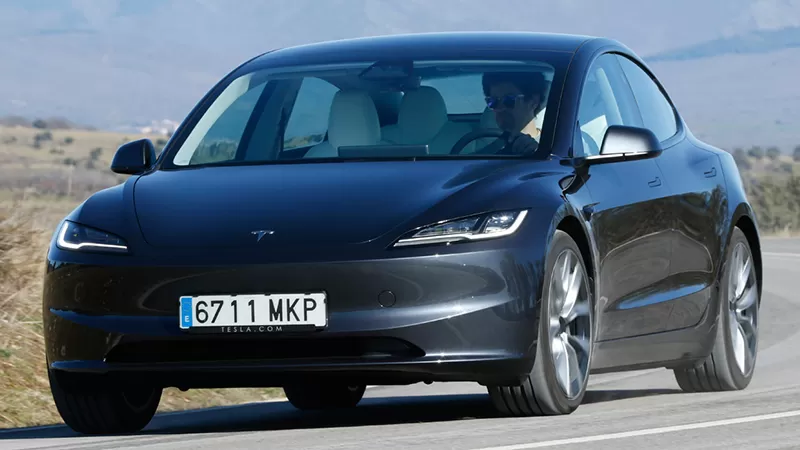Introducing the 2024 Tesla Model 3 Highland – while it may not appear drastically different at first glance, this latest iteration has undergone significant updates, marking its first major revision in nearly seven years. Let’s delve into the details, exploring the quirks, features, and improvements that set this model apart.
Table of Contents
Starting with the Tesla Model 3 Highland exterior, subtle yet noticeable changes adorn the front and rear end, giving the Model 3 a more modern aesthetic. From updated headlights to redesigned tail lights and a sleeker badge placement, every detail contributes to a refreshed look. Additionally, Tesla has introduced two new paint colors – Arrow Gray and Stealth Red – adding further customization options for enthusiasts.
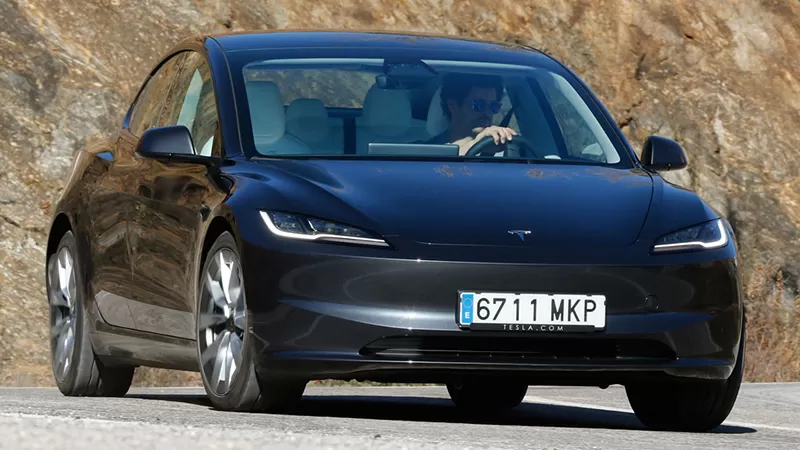
Step inside the updated Model 3, and you’ll immediately notice the refined interior. Tesla’s focus on enhancing quality and premium feel is evident, with new materials adorning the dashboard and door panels. The highlight of the rear cabin is the new 8-inch touch screen display, offering rear passengers control over entertainment, climate, and more. With heated rear seats and dual wireless charging pads, comfort and convenience take center stage.
Under the hood, the Model 3 continues to impress with its performance and efficiency. Two trim levels are available – the base model with rear-wheel drive and the long-range dual-motor variant. With improved aerodynamics and a Next Generation premium sound system, Tesla delivers an unparalleled driving experience.
While the Model 3 excels as a daily commuter, it’s not without its quirks. Tesla’s minimalist approach to controls, including the absence of traditional stocks, may take some getting used to. However, features like the blind-spot camera, Sentry mode, and Dog mode showcase Tesla’s commitment to innovation and safety.
On the road, the Tesla Model 3 Highland shines with its quick acceleration and autopilot capabilities, making city driving a breeze. While it may not evoke the same excitement as a sports car, its efficiency and ease of use make it an ideal choice for urban dwellers and commuters alike.
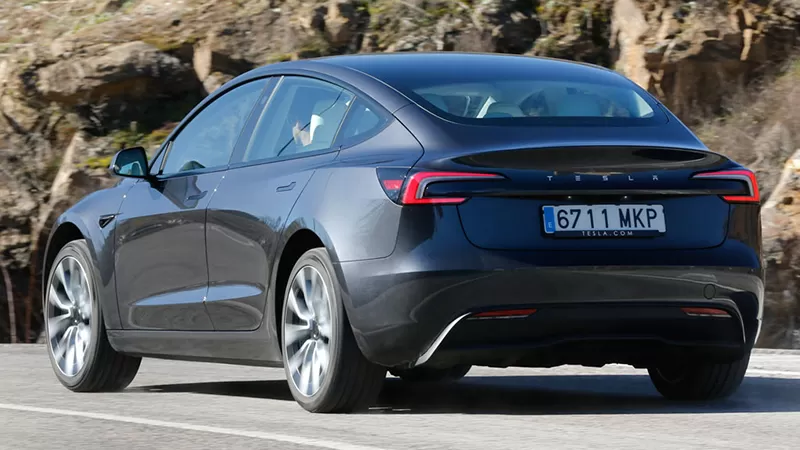
The Tesla Model 3 Highland may not be the most thrilling car on the market, but it excels in its role as a practical and reliable mode of transportation. With its sleek design, advanced technology, and impressive performance, it sets a new standard for electric vehicles. Overall the Tesla Model 3 earns a respectable Doug Score of 63 out of 100, showcasing its prowess as a daily driver while acknowledging its limitations in the realm of excitement and thrill.
The Tesla Model 3 Highland, particularly the updated Highland version, remains the top choice for electric vehicle enthusiasts. With the Model Y gaining popularity and becoming the best-selling car globally, the debate between the Model 3 and Model Y arises. Let’s delve into this review with Thomas Naefel in 4k full screen to explore the updated Model 3.
Starting with the exterior, the new headlamps, now equipped with a matrix LED feature for night driving, enhance visibility and safety. The updated model also offers new color options and wheel choices, striking a balance between design and comfort. The aerodynamic enhancements, including blacked-out elements and improved noise insulation, contribute to a more efficient and quieter driving experience. Additionally, the range options cater to different needs, with the choice between short range and long range models, both offering impressive performance.
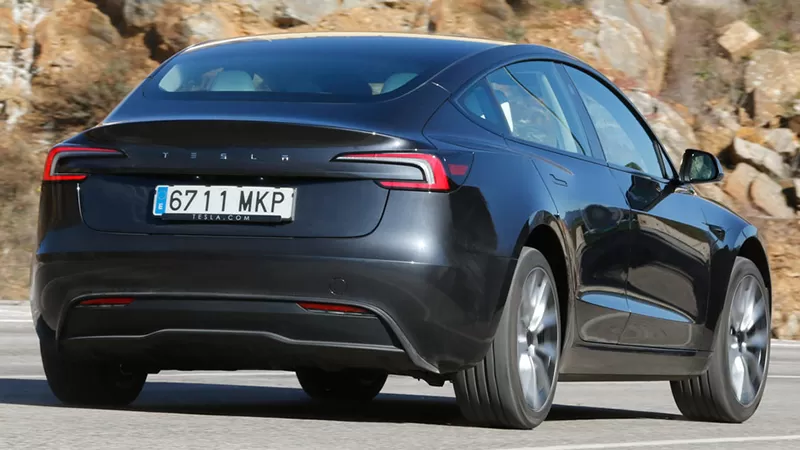
Inside the cabin, the attention to detail is evident, with premium materials and thoughtful features like seat cooling and heating. The infotainment system is intuitive, offering controls for various functions, including climate and seating adjustments.
The driving experience is where the Model 3 truly shines. With responsive steering and impressive acceleration, it offers a thrilling yet comfortable ride. The adaptive features, such as lane-keeping assist and cruise control, enhance safety and convenience on the road. In terms of practicality, the Tesla Model 3 Highland trunk space, though not as large as the Model Y’s, is still ample and well-organized. Charging is convenient, especially with access to Tesla’s supercharger network, providing decent charging times.
Overall, the Tesla Model 3 Highland impresses with its performance, comfort, and efficiency, making it a compelling choice in the electric vehicle market. While the Model Y offers additional space and practicality, the Model 3’s driving dynamics and premium features make it a standout option. Whether you choose the Model 3 or Model Y depends on your priorities, but rest assured, both offer an exceptional driving experience backed by Tesla’s innovative technology and commitment to sustainability.
The Tesla Model 3 Highland, particularly the updated Highland version, remains the top choice for electric vehicle enthusiasts. With the Model Y gaining popularity and becoming the best-selling car globally, the debate between the Model 3 and Model Y arises. Let’s delve into this review with Thomas Naefel in 4k full screen to explore the updated Tesla Model 3 Highland.
Tesla Model 3 Interior:
Starting with the exterior, the new headlamps, now equipped with a matrix LED feature for night driving, enhance visibility and safety. The updated model also offers new color options and wheel choices, striking a balance between design and comfort.
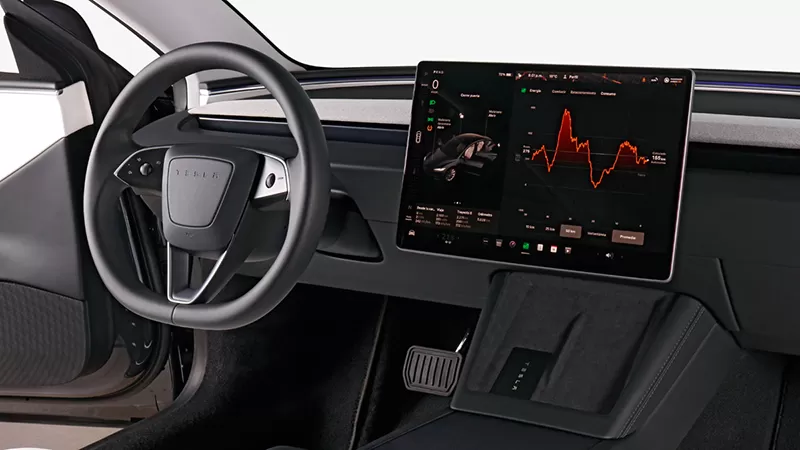
Inside the cabin, the attention to detail is evident, with premium materials and thoughtful features like seat cooling and heating. The infotainment system is intuitive, offering controls for various functions, including climate and seating adjustments.
The driving experience is where the Tesla Model 3 Highland truly shines. With responsive steering and impressive acceleration, it offers a thrilling yet comfortable ride. The adaptive features, such as lane-keeping assist and cruise control, enhance safety and convenience on the road.
In terms of practicality, the Model 3’s trunk space, though not as large as the Model Y’s, is still ample and well-organized. Charging is convenient, especially with access to Tesla’s supercharger network, providing decent charging times.
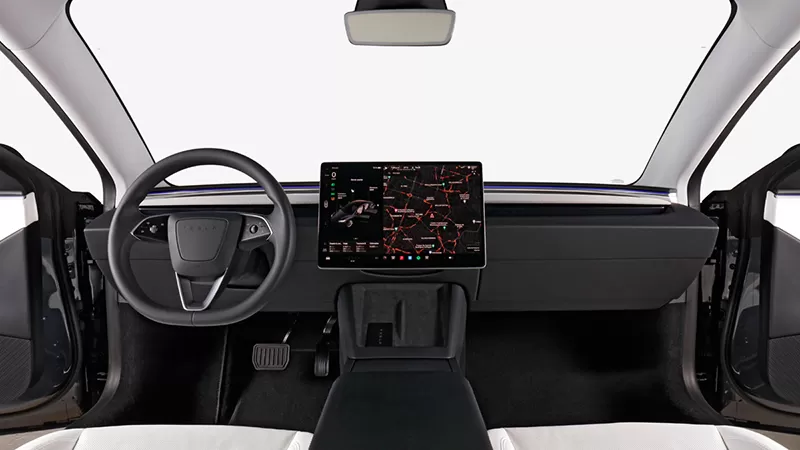
2024 Tesla Model 3 Highland Test General Information:
The Tesla Model 3 Highland of 2024 – known internally as the Highland project – is a deep update of the current generation of the Model 3, which arrived in 2017 on the Spanish market and which already received a refresh in 2020. In this latest revision, Tesla has not only visibly changed the aesthetics, but has also introduced relevant new features in sections such as suspension and acoustic insulation, resulting in a significantly more comfortable and less agile car.
There are two versions: Model 3 (283 HP , rear-wheel drive and 513 km of WLTP autonomy) and Model 3 Long Range (498 HP , all-wheel drive and 612 km). They are for sale for 39,990 and 49,990 euros respectively. From our point of view, the basic version offers practically everything that an average driver can demand: good acceleration capacity, low consumption and enough highway autonomy to do runs of more than 300 kilometers between recharges.
Tesla Model 3 Performance:
The rear-wheel drive Tesla Model 3 Highland is the most affordable model in its segment. while the BMW i4 and the Polestar 2 are noticeably more expensive. A rear-wheel drive Hyundai IONIQ 6 (228 HP) is also much more expensive than the Tesla, although the Hyundai’s approved range is 100 kilometers greater.
In the case of the Great autonomy and all-wheel drive version, the BYD Seal Excellence AWD wins the price game by about 2,200 euros, although the Tesla surpasses it in approved autonomy by more than 100 km. The BMW i4 and the Polestar 2 are again in a much higher price range (especially the BMW.
The dashboard maintains its design practically unchanged, but there are new coatings and the feeling of perceived quality is superior. The materials are softer and more pleasant to the touch, and the center console plastics have a matte finish instead of gloss black. Also new is an ambient lighting system for the dashboard and front doors. Likewise, there are changes to the seats, which have a different distribution of the foam and new upholstery.
Acoustic insulation is better thanks to measures such as laminated glazing on the rear windows and the windscreen (this type of glazing was only available on the front windows and windshield) and tires with lower rolling resistance. There are no changes in the space allocated for passengers, which is still good, although in the back row there is now an 8-inch screen so that the occupants of these seats can control the ventilation system, the seat heating or the multimedia system.
There are no levers on the steering column. As in the Tesla Model S, the turn signals are activated from controls on the left arm of the steering wheel, while the selection of gear positions is carried out from the multimedia system screen.
On the outside, there are obvious changes at both ends. The bumper and lights are new at the front. The bumper has a much simpler and cleaner design, without fog lights, without side openings and without parking sensors (these have been replaced by a camera system. Behind, there are new drivers and the Tesla logo disappears in favor of the letters of the brand name. For the body there are two new colors: Ultra Red and Stealth Gray (both optional, priced at €2,000).
To accelerate from 0 to 100 km/h, the rear-wheel drive version needs 6.1 seconds and the all-wheel drive version needs 4.4. These figures are identical to those of the previous Model 3. What has changed, for the worse, has been the top speed, since in both cases it is now 201 km/h, when before it was 225 and 233 km/h respectively.
The approved autonomy has improved by about 25 kilometers, in part, to a slight reduction in aerodynamic resistance (the Cx goes from 0.23 to 0.22) and to new tires (they have one less layer of fabric in the casing to reduce their mass; and also the maximum speed they can support). The new tires also help achieve less resistance.
The rear-wheel drive Tesla Model 3 Highland has a 60 kWh lithium-ion battery with LFP chemistry, while in the Grand Autonomy it is 75 kWh and NCA chemistry. LFP batteries have less energy density and charge at a slower rate, but they withstand deeper charges and discharges without degrading, so they have a longer life. we explain the advantages and disadvantages of each of these chemical compositions.
Standard and optional equipment is the same regardless of the version. Some of the elements that come standard are: active speed programmer, peripheral vision cameras (side and rear, there is no front), vehicle detection in the blind spot, heated front and rear seats (the front ones are also ventilated), multimedia system with 15.4-inch screen, 17-speaker audio system , electrically operated trunk lid, matrix LED headlights (although the light beam adaptation function is not yet available) and 18-inch wheels.
As an option there are things like metallic paint (blue, red, gray or black; white is standard), 19-inch wheels (which reduce the range by about 45 km), the tow ball, white upholstery and improvements in driving assistance systems, such as automatic lane change or traffic light and stop sign control (the car stops by itself when it detects a red light or a stop sign).
2024 Tesla Model 3 Highland Interior:
The appearance of the Tesla Model 3 Highland cabin has changed very little in general terms. It maintains the usual minimalist concept, with a large screen in the center to manage all (practically) the vehicle’s functions. The changes that Tesla has made in the 2024 edition have been to improve the onboard experience for passengers, although in some points there have been setbacks.
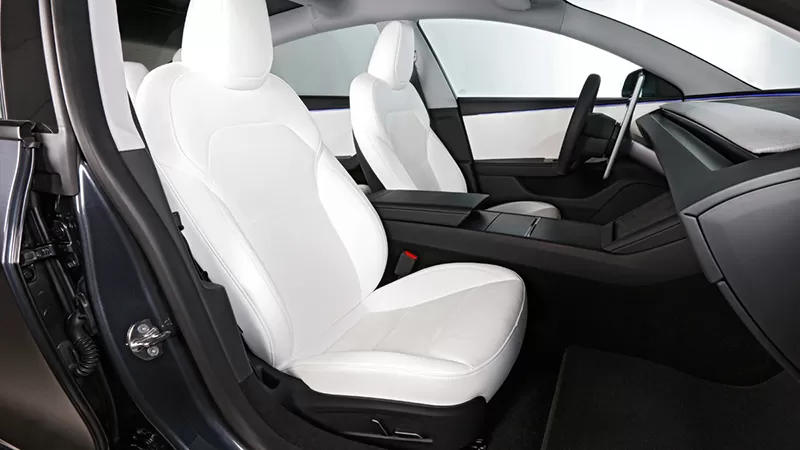
One of the first things you notice is an increase in quality. The very sound of closing the doors already denotes a superior solidity of construction. Most coating plastics are lightly cushioned and pleasant to the touch. It is not at the level of a BMW i4 or a Polestar 2, but on par with other competitors such as a BYD Seal. There are good details, such as the interior lining of the door wells and the absence of glossy black plastic.
Also new is the LED strip that runs along the entire upper part of the dashboard and the four doors the color can be chosen to taste through the central screen, The seat upholstery tries to imitate leather (without success) and can be black or, as an option, white. The latter brings more light to the interior, but is quickly marked by things like the dye on the jeans.
The seats have electric adjustments, they can be placed very close to the ground and their position is memorized in each user profile created through the multimedia system. I have missed the height adjustment of the headrest and the extension of the bench because it can be short for some people.
The padding is firmer than in the previous Tesla Model 3 Highland, but equally comfortable, and the edges are a little more prominent, which improves body support when cornering, one of the points we criticized at the time. Also new is the ventilation function, adjustable in three levels (they also have heating, as before).
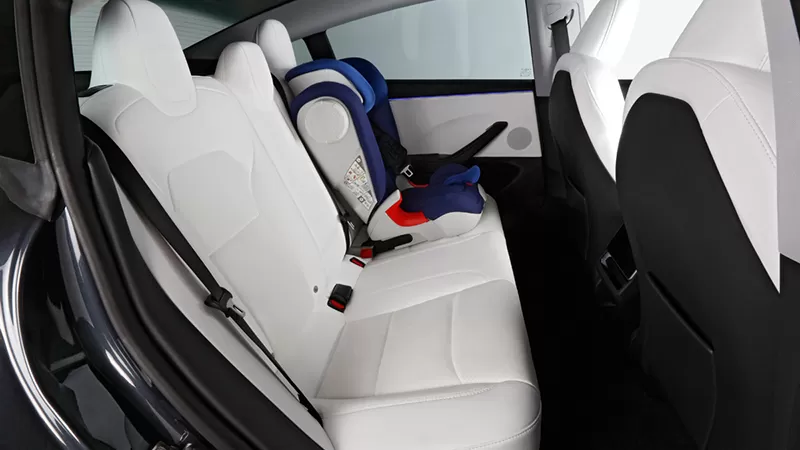
The steering wheel has a different design, with the rim slightly flattened at the bottom. It is still small in diameter, lined with a skin-friendly imitation leather material and electrically adjustable. The curious note is the seam of the ring, which is behind instead of the inner arch, something that is not always pleasant when in contact with the fingertips. The biggest novelty is, however, that there are now touch buttons to control the turn signals, like the Tesla Model S.
In this way, the traditional lever disappears and there is no possibility of requesting it as an option. It is a decision that entails more harm than benefit, an unnecessary solution from the point of view of making things easier for the driver. In the end you get used to it and you just complain about its location in the tight turns where you have to cross your hands and in some roundabouts.
The transmission selection lever also disappears, another idea inherited from the Model S. This function is performed from the screen and, again, is a step back in ergonomics . In previous editions of the Model 3 it was easier and faster to do maneuvers in which you have to change several times from D to R and vice versa.
As with the turn signals, you end up accepting it and getting used to it, but it is a nuisance that is only justified by the cost savings that eliminating components means for Tesla. In case of screen failure, gear selection can be done with touch buttons on the roof
The hardware and software of the infotainment system are still some of the best on the market today. The central screen is just as large as before (15.4 inches), but has a thinner bezel. Its graphic resolution and the fluidity with which it changes from one menu to another cannot be faulted. Also commendable is the structuring of the menus, which once you learn (for which it is not necessary to spend a lot of time researching) you can manage with little distraction.
There is no instrumentation behind the steering wheel or a projection system on the windshield and we miss having at least one of them. To check speed, range, battery charge status and other essential data, keep looking at the upper left corner of the central screen. I also still find it annoying that the autonomy and battery percentage cannot be displayed at the same time. Either you see one piece of information or you see the other.
The navigation system is good and its route calculations are usually accurate, but we miss that Tesla has not yet integrated compatibility with Android Auto and Apple CarPlay. However, if you want to use the mobile phone’s browser as a guide, just below the screen there are two surfaces where you can place it and take a look at it when necessary. These surfaces, both, are designed to charge two mobile devices by induction
The console between the front seats has two sliding covers that slide smoothly. Behind one of them there is a huge gap (with a USB-C socket and a cigarette lighter socket) and after the second, there are two coasters. There is also good storage space under the front armrest, where a second USB Type-C is located
The space in the rear row of seats is generous and allows two adults 1.85 meters tall to travel comfortably behind two others of the same size (three behind will not work well due to lack of width). It is clearly more spacious than a BMW i4 and a Polestar 2, while a BYD Seal is slightly wider and has softer seats that make them more comfortable (comparative table of interior measurements).
As happens in many electric vehicles – in all those mentioned in the previous paragraph, for example – the height of the seat with respect to the floor means that the knees are a little higher than normal in a combustion sedan and the thigh is not be fully supported. Removing that inconvenience, which is not annoying, the posture in the rear seats of the Tesla Model 3 Highland is comfortable. Getting a baby in and out of his seat is also comfortable because the rear doors have a good opening angle and the free space to maneuver is wide.
Rear passengers have an 8-inch screen in the center from which they can perform various actions. Among others, change the orientation of the air vents and the blowing force, activate the heating of the side seats (the center one does not have heating, in the previous Tesla Model 3 Highland it does), move the passenger seat forward or backward (this function is blocked when there is someone in front and the car is moving) and access multimedia content from various platforms.
It is possible to pair the screen with headphones via Bluetooth so that the audio is played through them and not through the car speakers. Another comfort that those in the back have is a folding armrest in the center (with two cup holders,
Tesla Model 3 Highland Overview:
The Tesla Model 3 Highland has two trunks, one in front and one in the back, of 88 and 425 liters respectively. The rear one is larger than that of the BYD Seal (400 liters) and the Polestar 2 (407 l) and smaller than that of the BMW i4 (470 l). Unlike all of them, the floor of the Tesla is not completely flat, but rather has two small longitudinal steps they are not usually a hindrance to taking advantage of the space).
Below there is a very large hole that can be used to carry charging cables or an airplane cabin suitcase Nowhere are there hooks or any type of solution to hang, for example, shopping bags so that the products do not come off at the first bend.
The tailgate, which is electrically operated as standard, does not open as much as on the previous Tesla Model 3 Highland. The lid is lower and you have to be careful not to hit your head. Above all, you must avoid corners, where the drivers form a very dangerous sharp edge, as it can cause a lot of damage.
The front trunk has a lid that opens and closes by hand. The available volume is double that of the Polestar 2 (41 liters) and considerably larger than that of the BYD Seal (53 liters). The BMW i4 does not have a front trunk. It is not carpeted like the rear trunk, but has a plastic bottom which can be useful for storing dirty things, like muddy boots, for example.
Of course, it does not have a drain, so when cleaning it it is better not to flood it with water. There is an illuminated button for emergency opening from the inside in case someone gets trapped inside
Tesla Model 3 Highland 2024: improved version, which is addictive:
The Tesla Model 3 Highland has been updated in many aspects, and driving it is an experience that translates into comfort and relaxation at the controls.
Tesla Model 3 Highland Turn Signals on the steering wheel:
On the other hand, the turn signal lever has been replaced by buttons on the steering wheel that are operated with the thumb of the left hand, as happens in the latest Ferrari or Lamborghini. It is another thing that requires habit, although no matter how much we activate them, it still seems easier to put the ones on the right side than the ones on the left (which requires lowering the thumb further).
And without being uncomfortable, we do not believe that this change is for the better; everything has been to ‘clean’ the dashboard and make it minimalist as much as possible.
The seats have also been renewed. They don’t have a sporty look but they hold well. They don’t seem to have hard foams either, but they are very comfortable. Heating in the front seats is standard, and ventilation could be fitted as an option, although with a generous profusion of holes in the white material that cannot be confused with genuine leather nor is it intended to be.
Taking a closer look we find here in front a USB-C socket (in addition to the two at the back), two wireless chargers for the phone, materials with a good touch and finishes that look like aluminum and are actually made of this metal.
Improved Signal Tesla Model 3 Highland
And although we may not notice it at first glance, this entry-level version comes with a sound system with 9 speakers, a subwoofer and a dual amplifier. It sounds very good, by the way. Of course, telephone communication is also more fluid thanks to additional microphones and a 50% improvement in the telephone signal.
As for the rear seats, once again the side seats are comfortable and we consider the central one acceptable , although not so much because of the backrest (somewhat hard in the center) as because of the flat floor and the correct height to the ceiling. In front of this central passenger, by the way, we now find a screen. The little ones will surely have a great time with it because it not only serves to independently regulate the air conditioning back here, but also for entertainment. And it also promises to incorporate new applications in the future thanks to Over the Air (OTA) updates.
Huge Trunk Tesla Model 3 Highland:
And all this space is rounded off with a trunk that is surprising, and that seems more typical of a grown-up SUV (about 4.5 meters long) than a sedan that is not bulky at first glance, although this Tesla Model 3 Highland is deceptive because it measures 4 .72 meters in length . We have no less than 594 liters of luggage behind the rear seats. And if when loading we remember the 88 that are also offered in the front hood, the result is 682 liters without the need to fold down any backrest; simply outstanding.
Saying that the march begins in silence is obvious. What is not so ‘free’ is the excellent sound insulation, the result of acoustic glass in all the moons and windows, the suspensions having been better coated and a greater amount of insulating materials and improved sealing. According to the American brand, wind noise has been reduced by 30%, rolling noise by 20%, ambient noise from outside by 30% and the perception of any impact from the outside by 25%.
Without having a way to measure this decrease, we are left with the incontestable fact that this interior is a ‘backwater’ as far as ‘acoustic peace’ is concerned. The only thing that breaks this peace, in fact, is the sound that the car now emits every time you exceed the speed limit, which we can actually silence (until the next time we start the car) by tapping between the menus on the screen.
The version we are driving is rear-wheel drive, which is the entry level to the Model 3 range. On paper, the 60 kWh of its battery is few (the one in the all-wheel drive version has 75 kWh, which is not outrageous either). ), but we must keep in mind that this Tesla Model 3 Highland is not an SUV nor does it have the aerodynamic drawbacks to which these cars are accustomed.

